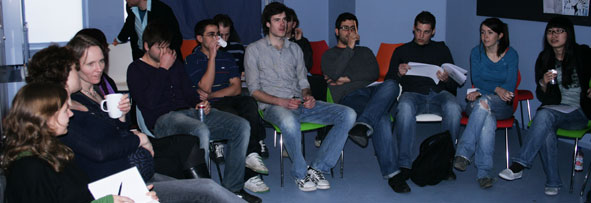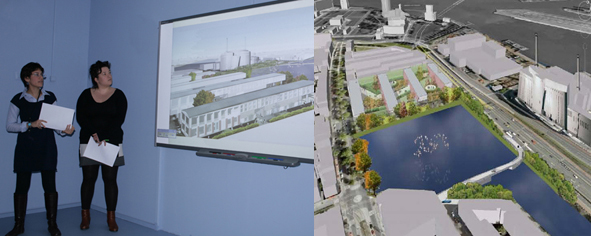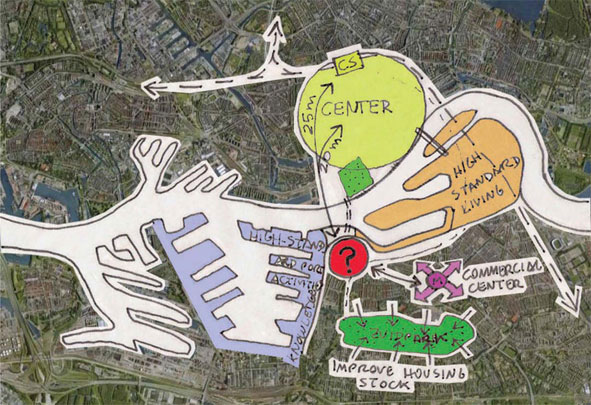In February next to the project "Design strategies for regeneration areas" (bachelor) there also started the project "Urban Design & City Analysis" (master) at the Field Academy Rotterdam. What sets those projects apart from the usual subjects given at the Faculty of Architecture is that the students also had to face the wishes and ideas of the people actually living and working in Oud Charlois. This authentic input that was given during the introductory Confrontation Lecture lead the students to formulate individual research tasks. Based on their extensive analysis and research within the district the students completed the course with (spatial) plans and strategies to improve the quality of life in Oud Charlois.
On March the 20th the plans were presented at the Field Academy.

The master students looked at Oud Charlois from a broader point of view and emphasized the situation of the district within its urban surrounding. While analyzing the area, they tried out the municipality's GIS-web (data collection and application) to show yet unknown relations between various factors.
Especially the non-Dutch view on the district by the foreign students resulted in surprising propositions.
Anna (Sweden) and Dena (Iran) suggest connecting Oud Charlois to the harbor areas that are being newly developed at the moment by the municipality. Physically and visually the north of Oud Charlois should be linked to the harbor to create a new appealing starting point. For the Karel de Stouteplein they consider a huge water reservoir. The integration of water into the old part of the area should help to connect this part with the harbor and forms an ecological addition and water collector.
Councilor Carina ... is impressed by the fresh vision and also the district manager is enthusiastic about some aspects of this "radical plan". At the same time there are skeptical remarks about the water reservoir and the disappearance of the Karel de Stouteplein.
Also the presentation of Rafael (Brazil) and Mark (Netherlands) puts Oud Charlois into a new perspective. For most of Rotterdam and local inhabitants it seems a given fact that the district is far from the city center. The two students demonstrate that this thought is rather based on subjective observations. A better connection and well defined entrance to Oud Charlois would make a reasonable difference in how the district is observed. According to them Oud Charlois is suitable as a "student city".

Anna and Dena defend their planned water reservoir

Rafael and Mark conclude: Charlois is a well accessible area in Rotterdam!
Combining the presentations and the input given by the professionals it is possible to name several difficulties that the area has to overcome but also some chances that should not be left behind.
The (spatial) problems of the area are caused by:
• unattractive public space
• absence of a well defined center
• too few parking spaces (especially in respect to the wanted number of visitors)
• the high number of illegal tenants that cause deterioration in the long term
• undesirable amounts of youth hanging about on the streets
A few suggestions to improve the area are:
• change the square around the church and furnish it as a public space (cafe's, weekly market, ...)
• include inhabitants during spatial reintegration of the area
• give the inhabitants responsibility about pieces of semi-public space
• attract new inhabitants such as young entrepreneurs and students (avoid gentrification)
• connect Oud Charlois to the north side of the Maas
• youth center in the heart of the district
• image improvement
The students, teachers and professionals agree that some of the present qualities could play a key role in the improvement of the image and help to attract new inhabitants. The great number of artists in Oud Charlois could be used as a crowd puller and also to present the area in a new way. Also the unique "village like" character is very special for a district in such an urban surrounding.
During the presentations the discussion repeatedly turned to the question about how much influence the urban designer actually has on the social structure of a (regeneration) area. Reacting to this subject, district manager Irma Bijl encouraged the students to see themselves as more than "only" urban planners.
At the end of the day Otto Trienekens concluded that the presentations should not end up locked up in the archive but that the municipality and other parties involved should take interest in the new and refreshing ideas.